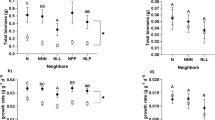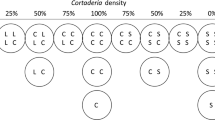Abstract
An introduced plantation tree species, Acacia mangium Willd., is becoming invasive in the Brunei region of Borneo. To examine its invasive potential, a greenhouse, additive series experiment (target–neighbour) involving seedlings of A. mangium and those of a common native heath-forest (kerangas), Melastoma beccarianum Cogn. was carried out under low and high light regimes in intra- and interspecific combinations over a 6-month period. Significant variations in growth parameters (other than biomass allocation patterns) existed amongst seedlings from different treatments. A major part of this variation in growth could be attributed to the main factors of target species, neighbour species, and competition (seedling density). For the growth variables examined, the target–species response was not consistent across light regimes. Under high light conditions, Acacia was the better competitor; the Lotka-Volterra competition coefficient effect of Melastoma on Acacia was lower (α=0.30) than the effect of Acacia on Melastoma (β=0.54). However, the reverse occurred under low light conditions with Melastoma gaining the upper hand (α=1.45 and β=0.44). These results show that light (and hence disturbance) can strongly influence the pattern and intensity of both intra- and interspecific competition between invasive and local flora species. Relatively intact forest is unlikely to be invaded by Acacia trees (as they are poor competitors under this scenario). On the other hand, the Acacia trees can easily invade disturbed forests, especially those prone to recurring drought and fire, and over time convert the habitats to nearly monospecific stands, as is presently being observed in Brunei.



Similar content being viewed by others
References
Ajik M (2002) Acacia species planting trial at Segaluid Lokan, Sandakan, Sabah, Malaysia. J Trop For Sci 14:421–424
Baruch Z, Pattison RR, Goldstein G (2000) Response to light and water availability of four Melastomataceae in the Hawaiian Islands. Int J Plant Sci 161:107–118
Chey VK, Intachat J (2000) Acacia plantations in Malaysia and their pests. Planter 76(888):171–190
Connolly J, Wayne P, Bazzaz FA (2001) Interspecific competition in plants: how well do current methods answer fundamental questions? Am Nat 157:107–125
Coode MJE, Dransfield J, Forman LL, Kirkup DW, Said IM (1996) A checklist of flowering plants and gymnosperms of Brunei Darussalam. Ministry of Industry and Primary Resources, Brunei Darussalam
Davies SJ, Becker P (1996) Floristic composition and stand structure of mixed dipterocarp and heath forests in Brunei Darussalam. J Trop For Sci 8:542–569
De Wit MP, Crookes DJ, Van Wilgen BW (2001) Conflicts of interest in environmental management: estimating the costs and benefits of a tree invasion. Biol Invasions 3:167–178
Freckleton RP, Watkinson AR (2001) Predicting competition coefficients for plant mixtures: reciprocity, transitivity and correlations with life history traits. Ecol Lett 4:348–357
Gerry AK, Wilson SD (1995) The influence of initial size on the competitive responses of six plant species. Ecology 76:272–279
Gibson DJ, Connolly J, Hartnett DC, Weidenhamers JD (1999) Design of greenhouse studies of interactions between plants. J Ecol 87:1–16
Goldberg DE, Fleetwood L (1987) Competitive effect and response in four annual plants. J Ecol 75:1131–1143
Gorchov DL, Trisel DE, (2003) Competitive effects of the invasive shrub, Lonicera maackii (Rupr.) Herder (Caprifoliaceae), on the growth and survival of native tree seedlings. Plant Ecol 166:13–24
Gordon DR (1998) Effects of invasive, non-indigenous plant species on ecosystems processes: lessons from Florida. Ecol Appl 8:975–989
Groves RH (1986) Plant invasions of Australia: an overview. In: Groves RH, Burdon JJ (eds) Ecology of biological invasions. Cambridge University Press, Cambridge, pp137–149
Hartnett DC, Hetrick AD, Wilson WT, Gibson DJ (1993) Mycorrhizal influence on intraspecific and interspecific neighbour interactions among co-occurring prairie grasses. J Ecol 81:787–795
Holmes PM, Cowling RM (1997) The effects of invasion by Acacia saligna on the guild structure and regeneration capabilities of South African fynbos shrublands. J Appl Ecol 34:317–332
Jeffrey DJ, Holmes PM, Rebelo AG (1988) Effects of dry heat on seed germination in selected indigenous and alien legume species in South Africa. S Afr J Bot 54:28–34
Kahar SR (2002) Invasion by the exotic Acacia mangium willd in highly degraded heath vegetation within Berakas forest Reserve, Brunei. BSc Thesis, Universiti Brunei Darussalam, Brunei
Kaiser J (1999) Stemming the tide of invasive species. Science 285:1836–1841
Keddy PA (1989) Competition. Chapman and Hall, New York
Lodge DM, Shrader-Frechette K (2002) Non-indigenous species: ecological explanation, environmental ethics and public policy. Conserv Biol 17:31–37
Mack RN (1996) Predicting the identity and fate of plant invaders: emergent and emerging approaches. Biol Conserv 78:107–121
Mack RN (2000) Cultivation fosters plant naturalization by reducing environmental stochasticity. Biol Invasions 2:111–122
Meekins JF, McCarthy BC (1999) Competitive ability of Alliarai petiolata (garlic mustard, Brassicaceae), an invasive, non-indigenous forest herb. Int J Plant Sci 160:743–752
Milton SJ (1981) Litterfall of the exotic acacias in the South Western Cape. J S Afr Bot 47:147–155
Osunkoya OO, Ash JE (1991) Acclimation to a change in light regime in seedling of six Australian rainforest tree species. Aust J Bot 39:591 605
Osunkoya OO, Bujang D, Moksin H, Wimmer F, Thippeswamy HM (2004) Leaf properties and construction costs of common co-occurring plant species of disturbed heath forests in Borneo. Aust J Bot 52:499–507
Pattison RR, Goldstein G, Ares A (1998) Growth, biomass allocation and photosynthesis of invasive and native Hawaiian rainforest species. Oecologia 117:449–459
Richardson DM (1998) Forest trees as invasive aliens. Conserv Biol 12:18–26
Rouget M, Richardson DM, Nel JL, Van Wilgen BW (2002) Commercially important trees as invasive aliens—towards spatially explicit risk assessment at a national scale. Biol Invasions 4: 397–412
Snaydon RW (1991) Replacement or additive designs for competition studies. J Appl Ecol 28:930–946
Tilman D (1988) Plant strategies and the dynamics and structure of plant communities. Princeton University Press, Princeton
Turnbull JW, Midgley SJ, Cossalter C (1998) Tropical Acacias planted in Asia: an overview. In: Turnbull JW, Crompton HR, Pinyopusarerk K (eds) Recent developments in Acacia planting. ACIAR proceedings, vol 82. ACIAR, Canberra, pp14–28
Underwood AJ (1997) Experiments in ecology: their logical design and interpretation using analysis of variance. Cambridge University Press, Cambridge, UK
Van Wilgen BW, Richardson DM (1985) The effects of alien shrub invasions on the vegetation structure and fire behaviour of South African fynbos shrubland: a simulation study. J Appl Ecol 22:955–966
Van Wilgen BW, Richardson DM, Le Maitre DC, Marais C, Magadlela D (2001) The economic consequences of alien plant invasions: examples of impacts and approaches to sustainable management in South Africa. Env Dev Sustainability 3:145–168
Weigelt A, Jolliffe M (2003) Indices of plant competition. J Ecol 91:707–720
Williams AC, McCarthy BC (2001) A new index of interspecific competition for replacement and additive designs. Ecol Res 16:29–40
Williamson M, Fitter A (1996) The varying success of invaders. Ecology 77:1666–1670
Acknowledgements
UBD provided the grant [No: UBD/PNC2/2/RG/1(15)] that enabled us to carry out the research. We thank the Forestry Department, Brunei Darussalam for granting access to Acacia plantation sites in various localities in Tutong and Muara districts of Brunei. Dr. David Marshall’s help in reading various drafts of the manuscript is also appreciated.
Author information
Authors and Affiliations
Corresponding author
About this article
Cite this article
Osunkoya, O.O., Othman, F.E. & Kahar, R.S. Growth and competition between seedlings of an invasive plantation tree, Acacia mangium, and those of a native Borneo heath-forest species, Melastoma beccarianum. Ecol Res 20, 205–214 (2005). https://doi.org/10.1007/s11284-004-0027-4
Received:
Accepted:
Published:
Issue Date:
DOI: https://doi.org/10.1007/s11284-004-0027-4




